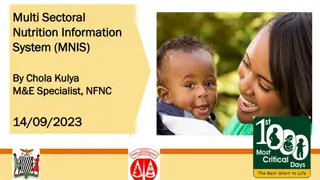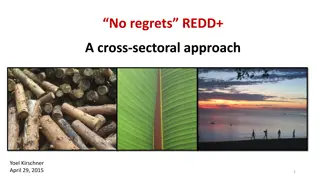Understanding DTM Multi-Sectoral Location Assessment for Partners
DTM, or Displacement Tracking Matrix, is a comprehensive tool used in 80 countries to track movements in various contexts like conflicts and natural disasters. The Multi-Sectoral Location Assessment within DTM involves components like Flow Monitoring, Mobility Tracking, and Registration Surveys to gather data for partner organizations. This briefing aims to provide an overview of DTM components, strengths, limitations, and practical uses for partners like Clusters, Authorities, WGs, Sectors, Donors, IOM Programmes, and other organizations. The assessment can be valuable for understanding population movements in emergency situations, aiding in beneficiary selection, vulnerability targeting, and programming decisions.
Download Presentation

Please find below an Image/Link to download the presentation.
The content on the website is provided AS IS for your information and personal use only. It may not be sold, licensed, or shared on other websites without obtaining consent from the author. Download presentation by click this link. If you encounter any issues during the download, it is possible that the publisher has removed the file from their server.
E N D
Presentation Transcript
What is DTM? How can DTM Multi-Sectoral Location Assessment be useful for Partners? Briefing for Partners. Partners include Clusters, Authorities, WGs, Sectors, Donors, IOM Programmes and other organizations
Objective of this Session At the end of this session you will be able to: 1. List the 4 DTM components 2. List Strengths and Limitations of DTM Multi Sectoral Location Assessment 3. List uses of DTM Data by partners 4. Know where to find DTM Data and further information on DTM online
DTM OPERATIONS OVERVIEW Since its inception in Iraq in 2004, DTM has expanded its coverage to reach 80 countries. Past and present implementation contexts include conflicts, natural disasters and complex emergency settings, from small- scale & short-term to large-scale and protracted displacement & migration crises.
DTM Components FLOW MONITORING Tracks movement of flows at specific points MOBILITY TRACKING Tracks mobility and cross- sectoral needs in locations of interest (systematically) Groups and Location Sub-components: Baseline Area/ Sub Area Multi Sectoral Location Assessment (Stock population) Emergency Event Tracking (Sudden large movement of population) Sub-components: High mobility location assessment Flow Monitoring Registry REGISTRATION SURVEYs Gather specific information using sample from population of interest Registers individuals or households for beneficiary selection, vulnerability targeting and programming Households and Individuals Examples: Return Intention Community Perception Displacement Solutions Flow Monitoring Surveys Sub-components: Rapid Emergency Registrations Biometric Registration
Not all DTM components are always rolled out in every country: DTM is implemented according to need, so different components may be rolled out in different countries.
We look at Location Assessment When Initial displacement Protracted displacement Regular monitoring MOBILITY TRACKING Groups and Location How? Key informants Interviews (Not sectoral experts) Enumerators observation (Not sectoral experts) Sub-components: Baseline Area Assessment Baseline Sub Area Assessment Multi Sectoral Location Assessment Multi Sectoral Location Assessment (Stock) (Stock) Emergency Event Tracking (Sudden large movement of population) Where? Locations: IDP Camps/Sites/Villages/Neighb ourhood
How is DTM Multi-Sectoral Location Assessment implemented? DTM Location Assessment: It is implemented at regular intervals & can monitor changes over time It collect inter-sectoral data (population, locations ), in addition to some sectors-specific data Is carried out mostly through Key Informants Interviews and Observation Does not interview samples of individual or HH Is carried out at community level (not at facility level) Does not interview sectoral specialists Enumerators are notsectoralspecialists Information is triangulated with more key informants per location
Obstacles to meeting basic needs & DTM Location Assessment DTM Location Assessment focuses on access, availability and quality Obstacles to meeting basic needs are normally related to quality, availability awareness, use of or access to goods or services. Types of Obstacles to meeting basic needs Availability Access Quality Use Awareness Human resources Production Physical Knowledge Message Issues related to awareness and use generally require household-based assessment approaches Trade Financial Safety Attitude Channel DTM Location Assessment uses primarily Key Informants Interviews: therefore it mostly focus on issues related to access, availability and quality of goods and services. Security Reliability Practice Frequency Stock Social discrimina tion Diversity Transfer Dignity Visual is adapted from: Basic Needs Assessment Guidance and Toolbox, available at: https://reliefweb.int/report/world/basic-needs-assessment-guidance-and-toolbox
Strengths and Limitations of DTM Location Assessment Strengths Has often a very large territorial reach within the country Limitations Is implemented in a large number of crisis (very likely you will find a DTM exercise in your country of operation) Cannot ask questions that require a specific sectoral knowledge Cannot provide statistically representative information Cannot replace sectoral, in- depth assessments /monitoring tools Is not programme monitoring It is flexible, and can be adjusted according to the needs of humanitarian actors: it provides useful data for response Data are shared quickly. Most data are shared publically, some through Data Agreements. Data for urgent action can be shared in real time. Global experts, including Global Cluster and DTM have agreed on a list of recommended questions for Location Assessments
How do Partners use DTM Multi- Sectoral Location Assessment Data? Use DTM estimates of population and groups at location and national level for planning and advocacy Use DTM geo coordinates of locations hosting IDPs for operational decision-making Use results to monitor change over time by location, region and at national level for planning and operational response Use DTM data to monitor access to services in locations on an ongoing basis Use DTM data to monitor risks in locations on an ongoing basis Use DTM data to spot sectoral red flags/alerts, and follow up Use DTM data to prioritize locations for their in-depth assessments
Do you want to know more on DTM? DTM Frequently Asked Questions 2-pager answers the main questions about DTM. You can downloaded it from DTM&Partners Toolkit Methodological Framework used in Displacement Tracking Matrix Operations for Quantifying Displacement and Mobility describes DTM components in details. You can downloaded it from DTM&Partners Toolkit
Where can you find DTM reports and data? DTM public data and reports are online and available at: https://displacement.iom.int/, and http://www.globaldtm.info/ (through a search by Country). For questions and support, contact the DTM coordinator in your country (ask DTMSupport@iom.int for his/her contact details).
Recap Exercise Can you Say where to find DTM Data & Reports online? Say where to find more info on DTM online? List 3 ways Partners use DTM Data? List 3 Strengths of DTM Location Assessment List 3 Limitations of DTM Location Assessment List the 4 DTM components
How can DTM and Partners better engage & obtain useful data for response? We identified common reasons for partial use of DTM data We jointly worked on solutions that both DTM and Partners can implement Next segment will introduce solutions to these challenges and explain how DTM and Partners can better work together DTM & Partners Toolkit: https://displacement.iom.int/dtm-toolkit/dtm-partners-toolkit























